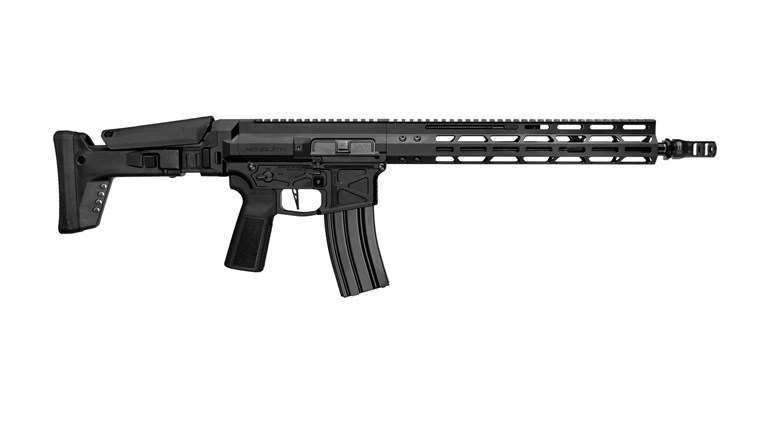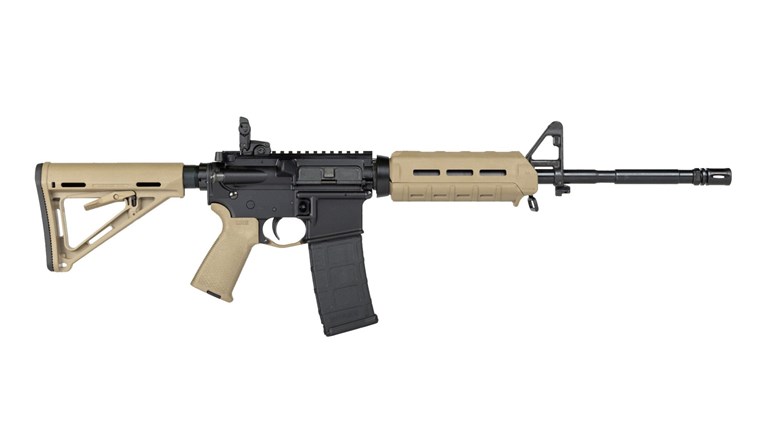
In fact, according to R.L. Wilson's book, "Ruger & His Guns," Bill Ruger envisioned the Mini-14 to be, "a miniaturized M14 to take the .223 cartridge…Just like the M1; but it's scaled way down in proportion to the M14 as the .223 is to the .308 or .30-06."
Its short 18.5-inch barrel and 6.25-pound heft gave it the same pointability and approximate balance as the M1 Carbine. Indeed, combining the attributes of three proven battlefield rifles—the M1 Garand, the M1 Carbine and the M1A1—makes one wonder: Had the Mini-14 come out in the 1960s instead of 1975, would the U.S. Army have adopted it instead of the M16? Ruger had this same thought, and while he had an uncanny knack for timing with most of his guns, the Mini-14's late arrival—well after the Vietnam War—frustrated him greatly.
Nonetheless, Ruger gladly settled for the rest of the Mini-14's intended audience as described in an early Ruger ad, "Ranchers and outdoorsmen will recognize the advantages of this small, reliable autoloader…ideal for carrying in a saddle scabbard, pickup truck, camper, or afoot…Ideal for law enforcement and sporting use."

With Len Brownell doing the original stock configuration, and noted firearms designers Jim Sullivan (who also lent his skills to the M14, M16 and M4 carbine, among others), Harry Sefried and Ron Melcher revamping and perfecting the gas-piston-driven lockwork, the Mini-14 carried quite a pedigree. Its introductory price was an affordable $200, which immediately catapulted the Mini-14 to the front of the got-to-have-it line. It was a classic combination of style and function that placed it in the military/sporter category, much the same as the sporterized Springfields and Mausers of post-World War I popularity.
Ruger's use of investment castings and stamped-metal parts kept costs down, as did the use of American hardwood rather than walnut for the stocks. The lightly stained wood contrasted nicely with the Ruger's brushed-blued finish. Sling swivels were standard, as was a rear peep sight. Anyone familiar with the Garand felt right at home handling the Mini-14, with its M1-style operating-rod handle and Garand-style safety located toward the front of the stamped-steel trigger guard. Likewise, field stripping was as easy as the Garand (although the internal self-cleaning, fixed-piston gas system was completely different); the entire gun could be broken down into eight subassemblies in less than 1 minute. But, by examining the interior of the Mini-14, one could discover the hidden nuances that made the rifle unique—things like a steel-reinforced stock at critical stress areas and unbreakable steel coil music-wire springs, a concept Ruger first utilized on its earlier single-actions.
A five-round, staggered, detachable-box magazine was standard. Ten- and 20-round magazines were offered for a brief time as options. The 10-round magazine was dropped in 1979 and the 20-round mag was discontinued 10 years later. Since the "Assault Weapons" Ban expired, Ruger is again offering 20-round magazines for the Mini-14 and the Mini-14/F—a folding-stock version first marketed in 1982—in those locations where they are legal.

Until recently the Mini-14/30GB, with a flash hider and bayonet lug, was reserved for law enforcement and the military. These customers can also purchase a selective-fire version, the AC-556, which is capable of firing 750 rounds per minute in full-automatic mode. The fire selector is located on the rear, right-hand portion of the receiver and, in addition to full- or semi-automatic fire, can be set to provide three-shot bursts, further evidence of Jim Sullivan's involvement in the Mini-14. These highly effective rifles come with 20- and 30-round magazines and have either 13- or 18-inch barrels outfitted with flash suppressors. Another variation of the full-auto Mini-14, the AC-556F, is equipped with a folding stock and a shorter barrel.
Needless to say, over the years there have been innumerable changes to what began as a basic hunting rifle and evolved into a dual-personality firearm with tactical applications as well. The first notable alteration was substituting fiberglass for the wooden upper handguard, further reflecting the M14's heritage. In 1979, a stainless steel version of the Mini-14 was introduced. But, even more dramatic, was the introduction of the Ranch Rifle in 1982.

Offered in either blued or stainless steel, with a carbine-style curved buttplate, this rifle incorporated scope-mounting bases integral to the receiver, giving additional versatility to an already versatile gun. A patented buffer system was also added to help protect scopes from the ravages of recoil, and the bolt stop was modified to deflect cases sideways so they clear low-mounted scopes. And for those who didn't opt for glass on their guns, a folding peep sight was incorporated. Later, a polymer hood was added that covered the operating rod to protect both it and the shooter's hands.
Over the years, the Mini-14 has been used by numerous military forces—not to mention law enforcement units throughout the United States. In 1979 a specially marked Oklahoma Highway Patrol version was issued and in 1980, the Arizona Highway Patrol ordered 676 stainless steel rifles with wooden handguards and rubber buttpads. Other agencies, such as the NYPD's Organized Crime Control Bureau and the California Department of Corrections and Rehabilitation, have also made it their rifle of choice.
On the civilian side, the Mini-14 continues to serve in both home-defense and sporting capacities with a host of variations, all under the Mini-14 Ranch Rifle umbrella as both blued and hardwood-stocked, or stainless and synthetically stocked variations. One of the newest versions is chambered in 6.8 SPC, which has a sterling reputation for accuracy. There is also a stainless steel Target Rifle with either thumbhole laminated or Hogue OverMolded all-weather stocks, a tactical ATI folding-stock variation with a 20-round magazine and a muzzle brake and the black-synthetic-stocked Mini Thirty chambered for the 7.62x39 mm. Ironically, this cartridge was first used by the USSR during the era of the M1 Garand, thus bringing the Mini-14 full circle with the start of its heritage.



































